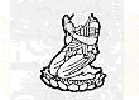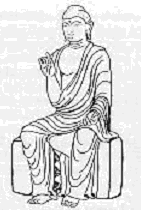 |
|
.
e
.
n
 |
 |
 |
 |
 |
 |
 |
 |
 |
 |
 |
 |
 |
 |
|
STORIES, BOOKS & MEDIA
» koans, stories & words » zen readings » recommended books » book reviews » art & prints » audio, videos, DVD's ZAZEN MEDITATION GUIDE - Chapter 03. Sitting Postures There are several sitting postures that were found and used in meditation long ago, thousands of years in before the Buddha in fact. Following are the guides to the main and more popular ones. These have been used in meditation at least, from the time of the Buddha to present: a. Full-lotus posture: Posture 1, the best sitting posture in zazen Next, with your two palms up, the left one upon the right one with the ends of two thumbs lightly touch each other and with the pointing fingers make a small oval circle, which lay on your lap and closed to the area under the navel. Your backbone must be straight up but not stiff. Your nose should be in line with your navel; your left ear should be in line with your left shoulder and the same with your right ear and shoulder. In this position, your head is already in vertical position with your backbone. This posture will give you the most secure in sitting zazen. (See the Buddha or Bodhidharma in the pictures above). b. Half-lotus posture: Zazen Posture 2 c. Leg-folding posture: Zazen Posture 3 Your palms, as in the above postures, rest on your lap. You might little or no pain with this posture because both of your legs are on the pad. This method is called "leg-folding" in order to distinguish it from the two first postures which are called "leg-crossing". This posture is often called the "Burmese posture". Actually, it is very popular in the south-east countries of Asia such as Burma, Vietnam, Thailand, etc… d. Sitting on your feet: Zazen Posture 4 You will need a cushion to support your buttocks and feet when your two folded legs go backwards almost like kneeling. Your upper body rests on your upper legs folding upon your lower legs which rest on the mat, meanwhile your buttocks are on a part of the cushion. Of the four postures above, the best one is full-lotus posture. The second best one is the half-lotus posture, the third one will be the folding-leg posture, and the last one is the seiza because the two latter ones are less secure than the two first ones in zazen. However, you can use them interchangeably in a long period of zazen e. Using a chair or a stool: Zazen Posture 5 When you use a chair or a stool to sit zazen, the one thing which is different from the above postures is your feet rest on the floor and they should be in a parallel position and your back should not touch the back holder of the chair. A chair may be more secure than a stool, but a stool will alert you to a fall, helping you out of sleepiness.
SUPPORT ZENGUIDE.COM Purchase posters, art prints, media (music CD & DVD)
 CALLIGRAPHY SCROLL, TRANQUILITY
CALLIGRAPHY SCROLL, TRANQUILITY
by George Caso →Puchase this Item →More Art Prints & Media →Zen & Buddhism books |
s
.
t
.
o
.
r
.
i
.
e
.
s
.
,
.
.
b
.
o
.
o
.
k
.
s
.
.
&
.
.
m
.
e
.
d
.
i
.
a
.
 First, you have to put your right foot with the sole up on your left thigh and then put your left foot with the sole up on your right thigh. Your two knees touch the pad.
First, you have to put your right foot with the sole up on your left thigh and then put your left foot with the sole up on your right thigh. Your two knees touch the pad. It can be made in the same way with the full-lotus posture, except for one detail, one foot is placed on the opposite thigh and the other foot rests on the pad. Beginners will find the full lotus difficult, therefore the half-lotus posture is useful as you would not get pain as much as you might do in the full-lotus posture because one of your legs may rest on the pad.
It can be made in the same way with the full-lotus posture, except for one detail, one foot is placed on the opposite thigh and the other foot rests on the pad. Beginners will find the full lotus difficult, therefore the half-lotus posture is useful as you would not get pain as much as you might do in the full-lotus posture because one of your legs may rest on the pad. This posture is similar to the two previously described postures, except that your legs are folded but only laid on the pad, neither of them need be placed on the opposite thigh.
This posture is similar to the two previously described postures, except that your legs are folded but only laid on the pad, neither of them need be placed on the opposite thigh.  This posture is also called "seiza" meaning "sitting on feet" or Japanese traditional posture, because it is particularly used by Japanese practicioners.
This posture is also called "seiza" meaning "sitting on feet" or Japanese traditional posture, because it is particularly used by Japanese practicioners. This is the least secure posture in zazen. You may use this posture when you can not do any of the above ones, through a lack of flexibility or in case a health condition does not allow you to do so.
This is the least secure posture in zazen. You may use this posture when you can not do any of the above ones, through a lack of flexibility or in case a health condition does not allow you to do so.